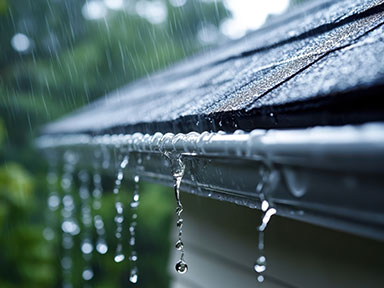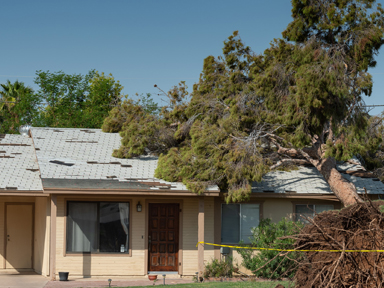Winter can be tough on properties, including rentals. During the season, all the elements have the potential to cause damage. However, with a little proactive maintenance, you can significantly lower the risk of nature taking its toll.
Here are a few maintenance tips to combat the elements at your rental property.
Water
Heavy rain, storms, hail and floods are common features of an Australian winter. In recent years there have been record-breaking rains and floods, hail and storms that have lashed properties from coast to coast. The high winds and deluges often leave damage in their wake, so it’s no surprise that insurance claims for water damage spike in winter.
Did you know? According to some sources, the highest rainfall recorded in a single day in Australia was on 3 February 1893 in Crohamhurst on the Sunshine Coast, when 907mm of rain was reported to have fallen between 9am and 9am (a 24-hour period).
Tips to help prevent water damage: Inspect your property inside and out: check the roof, gutters, drains, and external fittings for damage or leaks; ensure water drains away properly; protect pipes from freezing; and look for signs of water damage, mould, or hazards on walkways, ceilings, and walls.
Air/wind
Although November to April is prime time for cyclones in Australia, the winter months can also be a bit ‘blowy’. Damaging winds (when gusts of 90km/h or more are expected) and destructive winds (when gusts are likely to reach 125 km/h or higher) are a common feature in Australian severe weather and thunderstorm warnings.
Did you know? The strongest wind gust ever recorded in Australia, and indeed the world record for the fastest non-tornadic wind speed, occurred during Tropical Cyclone Olivia on 10 April 1996. As the cyclone passed over Barrow Island, located off the coast of Western Australia, an anemometer registered a wind gust of 408 km/h.
Secure the property against wind: trim overhanging branches, anchor loose structures, check that outdoor areas and fixtures are stable, and reinforce or secure roofing, siding, doors, and windows.
Fire
It has been estimated that up to 11,000 house fires occur in Australia every year – with a spike in insurance claims in winter. Common causes of winter home fires include logs and embers escaping a fireplace, electric heater failure, faulty chimney flues, faulty ducted heating, gas heaters, electric blanket failures, and bathroom heat lamps exploding.
Did you know? In just 60 seconds a house fire will have blown out of control and be giving off poisonous smoke. By the three-minute mark, the fire will have reached over 800°C, burned all the contents in the room it started in, and spread to other rooms in the home.
Tips to prevent fire damage: Reduce fire risk by inspecting electricals, servicing heating systems and fireplaces, clearing debris and overhanging branches, installing and testing smoke alarms, and providing fire safety equipment like extinguishers, blankets, and screens.
Earth
Landslides can be caused by earthquakes or volcanoes but, in Australia, the most common cause is heavy rain. This happens when rain saturates the soil on a hillside, past the point where any remaining vegetation can support the soil’s weight against the force of gravity, then the top saturated layer of soil slips down the hill, taking whatever is on the land with it.
Did you know? Since 1842, there have been hundreds of known landslides in Australia, but the worst one occurred at about 11.30pm on 30 July 1997. Around 1,000 tonnes of earth, rock and trees slipped rapidly down the steep slope when a large section of mountainside collapsed immediately above the Thredbo Ski Village in the NSW Alps.
Prevent landslide damage: Fix leaks, manage drainage, remove heavy materials from slopes, watch for signs of ground movement, avoid debris buildup, reinforce soil, and check retaining walls.
Insurance need-to-knows
Adequately maintaining the premises is a condition of cover. If you haven’t kept up-to-date with repairs and maintenance, you could find part, or all, of your claim rejected.
If the rental is damaged, it is important that you understand the obligation to act to prevent further loss is a condition of insurance. This means you may need to put up tarps, board up windows and doors or arrange urgent repairs.
There are legislated timeframes for making urgent and emergency repairs and you need to make sure you meet these – failing to do so can not only get you in hot water with the authorities but could also jeopardise your insurance cover.
Top tip: You should engage professionals to carry out inspections, installations and repair works, especially those in relation to heating, plumbing, roofing and electricals. Be sure to check that the tradie is insured and holds any required qualifications and licences.
Final words
While you can’t control the elements, some proactive maintenance can help reduce the risk of your investment property suffering damage this winter – and of you having to brave the elements to deal with repairs!
As an added bonus, it will also help safeguard your insurance policy. If you have questions about EBM RentCover landlord insurance policies and your obligations, have a chat with a member of our Expert Care team – 1800 661 662.
*While we have taken care to ensure the information above is true and correct at the time of publication, changes in circumstances and legislation after the displayed date may impact the accuracy of this article. If you need us we are there, contact 1800 661 662 if you have any questions.
You may also like
View all
When rain becomes more of a deluge than a dribble, you need to make sure your rental is prepared...

Claims for impact damage may not be an everyday thing, but they can and do happen...

Insurers reserve the right to place restrictions on accepting new cover. This is known as placing an ‘embargo’. Learn more...




